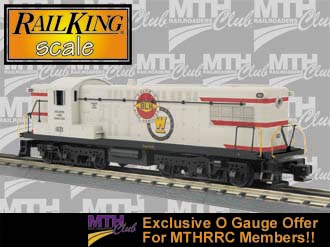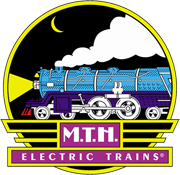Available Items

January 7, 2015 - In the summer of 1953, at the Railway Supply Manufacturer’s Association convention in Atlantic City, the state of the locomotive business was on full display. Among the engines representing EMD, the industry leader, was an F7 borrowed from a delivery to the New York Central. With nearly every class one road rostering its diesels, EMD hardly needed to field a demo locomotive.
In contrast, Fairbanks Morse, fighting to remain relevant, displayed its ultimate Hail Mary pass: the 2400 horsepower Train Master, in circus-like red and yellow demonstrator colors. Not far from that behemoth stood the last, best hope of America’s oldest locomotive builder: bright silver Baldwin AS-616 No 1601.
The logos on the side of No. 1601 told a story of industry consolidation, as once-dominant steam locomotive builders struggled to survive in the diesel era. Lima Locomotive Works, the smallest and most innovative of the former Big Three steam builders (Baldwin, Alco and Lima), had merged with motor builder Hamilton in 1947 to form Lima-Hamilton. Three years later, the new company merged with Baldwin to form Baldwin-Lima-Hamilton, and the Lima diesel line was discontinued.
Westinghouse, meanwhile, was competing with General Electric to supply electrical components to diesel builders, and invested heavily in Baldwin and then B-L-H to ensure their continued business. Thus the intertwined logos on No. 1601’s flanks told the story of four companies, now merged into two and fighting to compete in a maturing industry.
From the Atlantic City show, No. 1601 headed west to demonstrate on the Southern Pacific, home to 84 other six-axle Baldwin diesels. From there it traveled to a number of west coast short lines and was purchased by logging road Oregon & Northwestern as its No. 1. The former demonstrator survives today in the San Diego Railroad Museum in Campo, CA.
Relive Baldwin’s optimism and hope in the summer of ’53 with No. 1601 in its Atlantic City demo scheme. To our knowledge, this paint scheme has never been offered before in any scale. Thanks to Proto-Sound 3.0, our model features authentic Baldwin prime mover sounds and the ability to duplicate the low-speed lugging power of its prototype — as well as the ability to hustle along virtually as fast as you care to run it.
Full Disclosure: These Proto-Sound® 3.0 models will feature the correct engine No. 1601 silver demonstrator paint scheme, including the frame side slogan in yellow script: “they’re thrifty.” However, our tooling represents the original AS-616 body style and trucks, and does not allow for some details on the demonstrator that were new for the 1953 model year, including somewhat taller hoods, the placement of some louvers, and an upgraded truck design.
More about the Train Master
Built from 1950-1954, the AS-616 was Baldwin’s best-selling and final stab at the burgeoning road switcher market, which had been pioneered by Alco’s RS-1 and came to be dominated by EMD’s GP7 and GP9. In theory — and in practice with EMD Geeps — a road switcher was the perfect all-around diesel, equally adept at low-speed yard work or hustling mainline freight. And indeed, AS-616 stood for “All-Service, 6 axle, 1600 horsepower.” But the AS-616, like all Baldwin diesels, became typecast by its owners in one particular role: low-speed lugging of heavy loads, both in the yard and in mainline drag freight service.
This role stemmed from the De La Vergne diesel motors that powered all Baldwin units. Acquired by Baldwin in 1931, the De La Vergne Engine Company had started life in 1880 making mechanical refrigeration machines for breweries. Its power plant for Baldwin’s locomotives was unique among diesels of its time.
In order to make the fuel burn slower and give their 4-cycle engine a longer power stroke, De La Vergne’s designers used massive cylinders more than a foot in diameter and added a separate combustion chamber above each cylinder. To allow the fuel more time to burn, they ran the engine at a maximum speed of 625 rpm — just over half the speed of most competitive diesels. In the October 1936 issue of Baldwin Locomotives Magazine, the company claimed that “slow combustion gives low fuel consumption, absence of smoke, quick pick-up, and smooth idling.”
Ultimately the massive De La Vergne motor proved to be both a blessing and a curse. Teamed up with equally heavy-duty traction motors supplied by Westinghouse, Baldwin’s prime mover found its niche in low-speed, heavy tonnage lugging assignments, where engine crews admired Baldwin diesels because they just wouldn’t quit. But those were just the types of assignments in which crews tended to abuse equipment and push an engine to its limits. As a result, Baldwin engines eventually developed a reputation for high maintenance costs.
The early VO-1000 switcher, with its normally aspirated 8-cylinder engine, was one of Baldwin’s most dependable locomotives; but the turbocharged models that succeeded it, including the AS-616, were plagued by problems that included excessive piston wear and chronic oil leaks. In the early 1950s, when diesel power was new and railroads were trying engines from all manufacturers, 19 U.S. and Latin American railroads purchased 221 AS-616s (including 7 cabless B-units). Unlike most 6-axle diesels of its time, Baldwin’s road switcher had all 6 axles powered, thus enhancing its low-speed lugging ability. (Its competitors generally rode on so-called A-1-A trucks, with the middle axle being an unpowered idler used simply to spread out the engine’s weight for use on lighter-duty rail.) But by the middle of the decade, it was clear that Baldwin was no longer a contender in the diesel business. Westinghouse, its supplier of electrical motors and components, quit the locomotive business in 1954, and in 1956 the nation’s oldest locomotive builder threw in the towel.
Product Features
- Intricately Detailed ABS Body
- Die-Cast Truck Sides, Pilots and Fuel Tank
- Metal Chassis
- Metal Handrails and Decorative Horn
- (2) Engineer Cab Figures
- Authentic Paint Scheme
- Metal Wheels, Axles and Gears
- (2) Remote Controlled Proto-Couplers
- Prototypical Rule 17 Lighting
- Directionally Controlled Constant voltage LED Headlights
- Lighted Cab Interior
- (2) Precision Flywheel Equipped Motors
- Operating Smoke Unit
- Onboard DCC Receiver
- Locomotive Speed Control In Scale MPH Increments
- 1:48 Scale Proportions
- Proto-Sound 3.0 With The Digital Command System Featuring: Freight Yard Proto-Effects
- Unit Measures:14 1/2” x 2 1/2” x 3 3/4”
- Operates On O-31 Curves
Diesel DCC Features
- Headlight/Taillight
- Bell
- Horn
- Start-up/Shut-down
- Passenger Station/Freight Yard Announcements
- Lights (except head/tail)
- Master Volume
- Front Coupler
- Rear Coupler
- Forward Signal
- Reverse Signal
- Grade Crossing
- Idle Sequence 3
- Idle Sequence 2
- Idle Sequence 1
- Extended Start-up
- Extended Shut-down
- Rev Up
- Rev Down
- One Shot Doppler
- Coupler Slack
- Coupler Close
- Single Horn Blast
- Engine Sounds
- Brake Sounds
- Cab Chatter
- Feature Reset
- Smoke On/Off
- Smoke Volume







